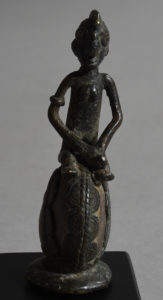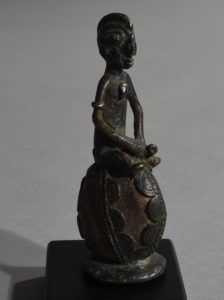NAK 1118-4
Male Bronze-Stone Figure, Dogon, Mali
This antique male figure of bronze encloses a round stone.
The figure represents most likely an ancestor or equally a Nommo, one of the eight Dogon primordial figures created by God. Dogon bronze figures like this were placed on a family altar or kept in the village priest’s shrine where they would have offerings meant to infuse them with life force and to assist humans on earth to intercede with the deities. Numerous terracotta, bronze, and brass objects have come to light from the great ‘Inland Delta Cultures’ of the Niger River and Benue River confluence. This figure could have been used as a shrine piece.
This unique figure is molded using the basic method of lost-wax casting that has been widely practiced on the African continent for several hundred years prior to the arrival of the first western visitors. The long tradition of figurative metal casting in the Western Sudan reaching back to the period of the great Empire of Mali as early as the 12th century is evident in this strongly modeled figure. This is an impressive piece of art that is seldom seen in Dogon sculpture.
The process begins with hard beeswax. It must however be soft enough for carving fine details, but hard enough to retain its shape. After the wax object has been carved, increasingly coarse layers of clay are applied to the object and allowed to dry. The first and finest clay slips capture the wax details in the smooth mold, and the coarser clay layers provide strength. The entire assemblage is fired, causing the original wax carving to melt away, leaving only a baked clay shell. Liquid metal (bronze, brass, lid, silver or gold) is poured into the empty mold and left to cool and harden. Later, the clay exterior is broken open, revealing the finished metal object beneath. In direct lost-wax casting, the object produced is always unique, as the mold is necessarily destroyed as part of the casting process. The method also called cire perdue in French.
Known for their art as well as their remarkable villages along the heights of the Bandiagara escarpment, Dogon art remains today some of the best known and most collected African art.
Dimension: H: 11, W: 3,5, D: 42 cm – weight 200 grams
Age: Est. Late 19th to early 20th Century.
Provenience: Private Belgian collection. Bought at a Brussels gallery.
Condition: The figure appears despite age in a beautiful glow. Both stone and bronze are fine and well-preserved without damage.
Literature: Germaine Dieterlen; “Masks and Mythology among the Dogon African Arts”
Request price for Dogon Bronze


